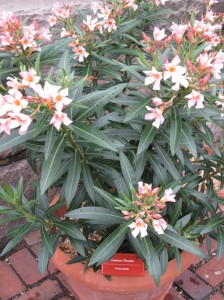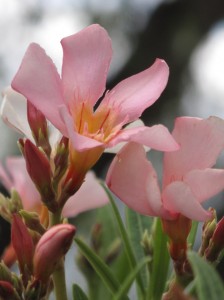Above, from left to right: Nerium oleander, a tender evergreen shrub native to the Mediterranean, is grown in pots at The Cloisters and brought indoors for the winter. Oleander belongs to the Apocynaceae, or Dogbane family, which contains many poisonous species. The five petals of the oleander flower are fused at the base and form a tube; the form of the flower is typical of this botanical family. Photographs by Corey Eilhardt.
Nerion, which some call Rododaphne, some Rhododendron . . . grows in enclosed greens and sea-bordering places & in places near rivers. But ye flower and the leaves have a power destructive of dogs & of Asses & of Mules & and of most four-footed living creatures, but a preserving one of men, being drank with wine against the bitings of venemous beasts & ye more if you mixed it with Rue, but ye more weak sort of living creature, as goats & sheep, die, if they drink ye maceration of them.
???Dioscorides, De Materia Medica, Book IV, 82
Nerium oleander was known to the Romans under all three of the Greek names given by Dioscorides. Pliny the Elder notes that there is no Latin name for the shrub; he concurs with Dioscorides on the destructive power of oleander, as well as its virtue as an antidote to snakebite.
The five-petaled blossom of the oleander was thought by the ancients to resemble a rose, although the plants??are botanically unrelated. The “rose” mentioned in Ecclesiastes (24:14, 39:13) is thought to be oleander. (The second name in the passage from Dioscorides quoted above, rododaphne, means “rose-laurel,” and the third, rhododendron, means “rose tree”.)
The flower of the oleander is typical of members of the Apocynaceae,??which includes many poisonous plants, as well as plants of medicinal value. The five petals of the corolla are fused into a tube; botanists call this type of inflorescence gamopetalous. (For an illustrated list of species in this botanical family, visit the Vascular Plant Image Library website.)
Oleander is a very poisonous plant; ingestion can induce severe diarrhea and vomiting. It??contains potent cardiac glycosides, which??affect the heart rate.?? All parts of the plant are toxic. Incidents, both in historical and modern times, in which oleander twigs have been used as skewers to cook meat have resulted in fatalities. Reactions to oleandrin??and nerin, the toxic principles found in the milky sap, can affect the central nervous system as well as the action of the heart, resulting in seizures, collapse, and coma.
The fifteenth-century herbal Hortus Sanitatis says that the flowers of oleander provoke sneezing, and recommends a poultice made of the fruit (see image) to induce sweating; a plaster made from oleander is said to relieve back pain. The Hortus maintains that oleander is fatal to fleas, worms, and scabies, but quotes Dioscorides as to its efficacy as an anti-venom when mixed with rue???a highly dangerous remedy.
Oleander is as beautiful as it is dangerous. Pliny makes no mention of the use of nerion as a garden plant, but it was grown ornamentally in ancient Roman gardens. Oleander is a common??species in Italy’s Campania region. Along with laurel and myrtle, it is one of the most commonly depicted plants in Roman wall paintings, including the famous frescoes that decorate the subterranean garden room from the Villa of Livia at Porta Prima.
In Italy, oleander is known as mazza San Giuseppe, or “Saint Joseph’s staff.” A flowering staff of oleander appears as his attribute in Renaissance paintings, especially in representations of the Marriage of the Virgin.
In Mediterranean climates, oleanders flower profusely from May through October. As Dioscorides noted, they can often be found growing wild along streams, but today they are also widely planted alongside roadways in Greece and Sicily, not only for their beauty, but because they are tolerant of drought and salt; their deep roots also serve to stabilize roadbeds. Oleander has also been used as a highway planting in California, and has naturalized in??parts of the United States.??????????????????????????????????????????????????????????????????????????????????????????????????????????????????????????????????????????????????????????????????????????
There are now more than 400 named forms of this ancient garden plant in cultivation. They are available in a wide range of colors; some forms have variegated leaves. For more on knowing and growing oleanders, visit the website of the International Oleander Society.
???Deirdre Larkin
Sources:
Anderson, Frank J., ed. ???Herbals through 1500,??? The Illustrated Bartsch, Vol. 90. New York: Abaris, 1984.
Farrar, Linda. Ancient Roman Gardens.?? Stroud: Sutton Publishing, 1998.
Grieve, Maude. A Modern Herbal. 1931. Reprint: New York: Dover Publications, 1971.
Griffiths, Mark. The New Royal Horticultural Society Index of Garden Plants. Portland, OR: Timber Press, 1992.
Gunther, Robert T., ed. The Greek Herbal of Dioscorides, translated by John Goodyer 1655. 1934. Reprint: New York: Hafner Publishing, 1968.
Levi D???Ancona, Mirella. The Garden of the Renaissance: Botanical Symbolism in Italian Painting. Firenze: L. S. Olschki, 1977.
Moldenke, Harold N. and Alma L. Moldenke. Plants of the Bible. Waltham, MA: 1952. Reprinted. New York: Dover Publications, 1986.
Tags: Apocynaceae, Dioscorides, Dogbane, Hortus Sanitatis, Nerium oleander



October 4, 2010 at 9:58 pm
As deadly as it is, I think I’ll admire the Oleander from a distance. I’m not sure I’d want to put it on my back as the toxins may enter through the skin. Thank you for the beautiful pictures and informative write up.
December 29, 2010 at 10:24 am
Yes, I was a little taken aback to discover how prevalent self-medication with oleander seems to be at the moment. It is certainly far too dangerous a plant to ingest or experiment with, and is best kept at a respectful distance.
D.